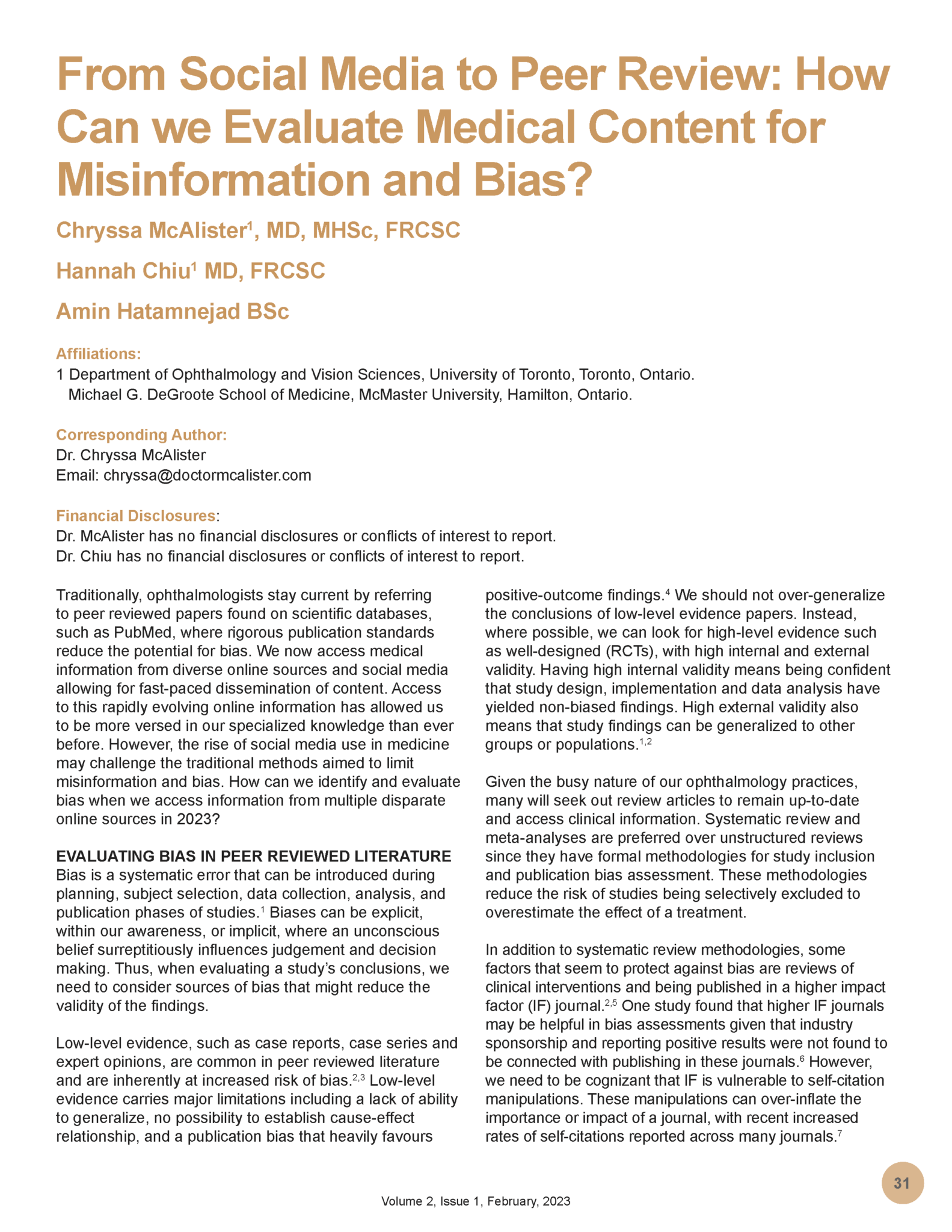From Social Media to Peer Review: How Can we Evaluate Medical Content for Misinformation and Bias?
DOI:
https://doi.org/10.58931/cect.2023.2124Abstract
Traditionally, ophthalmologists stay current by referring to peer reviewed papers found on scientific databases, such as PubMed, where rigorous publication standards reduce the potential for bias. We now access medical information from diverse online sources and social media allowing for fast-paced dissemination of content. Access to this rapidly evolving online information has allowed us to be more versed in our specialized knowledge than ever before. However, the rise of social media use in medicine may challenge the traditional methods aimed to limit misinformation and bias. How can we identify and evaluate bias when we access information from multiple disparate online sources in 2023?
References
Pannucci CJ, Wilkins EG. Identifying and avoiding bias in research. Plast Reconstr Surg. 2010;126(2):619-625. DOI: https://doi.org/10.1097/PRS.0b013e3181de24bc
Users’ Guides to the Medical Literature: A Manual for Evidence-Based Clinical Practice, 3rd ed. JAMAevidence. McGraw Hill Medical. [accessed 2022 Dec 30]. https://jamaevidence.mhmedical.com/Book.aspx?bookId=847.
Burns PB, Rohrich RJ, Chung KC. The levels of evidence and their role in evidence-based medicine. Plast Reconstr Surg. 2011;128(1):305-310. DOI: https://doi.org/10.1097/PRS.0b013e318219c171
Nissen T, Wynn R. The clinical case report: a review of its merits and limitations. BMC Res Notes. 2014;7:264. DOI: https://doi.org/10.1186/1756-0500-7-264
Ayorinde AA, Williams I, Mannion R, et al. Assessment of publication bias and outcome reporting bias in systematic reviews of health services and delivery research: A meta-epidemiological study. PloS One. 2020;15(1):e0227580. doi:10.1371/journal.pone.0227580 DOI: https://doi.org/10.1371/journal.pone.0227580
Ahmed Ali U, Reiber BMM, Ten Hove JR, et al. Journal impact factor and methodological quality of surgical randomized controlled trials: an empirical study. Langenbecks Arch Surg. 2017;402(7):1015-1022. doi:10.1007/s00423-017-1593-6 DOI: https://doi.org/10.1007/s00423-017-1593-6
Chorus C, Waltman L. A large-scale analysis of impact factor biased Journal self-citations. PLoS ONE. 2016;11(8):e0161021. doi:10.1371/journal.pone.0161021 DOI: https://doi.org/10.1371/journal.pone.0161021
Guyatt GH, Oxman AD, Vist G, et al. GRADE guidelines: 4. Rating the quality of evidence–study limitations (risk of bias). J Clin Epidemiol. 2011;64(4):407-415. DOI: https://doi.org/10.1016/j.jclinepi.2010.07.017
Gusenbauer M. Google Scholar to overshadow them all? Comparing the sizes of 12 academic search engines and bibliographic databases. Scientometrics. 2019;118(1):177-214. DOI: https://doi.org/10.1007/s11192-018-2958-5
Beel J, Gipp B. Google Scholar’s Ranking Algorithm: An Introductory Overview. Computer Science. 2009.
Boeker M, Vach W, Motschall E. Google Scholar as replacement for systematic literature searches: good relative recall and precision are not enough. BMC Med Res Methodol. 2013;13:131. DOI: https://doi.org/10.1186/1471-2288-13-131
Rovira C, Codina L, Lopezosa C. Language bias in the Google Scholar ranking algorithm. Future Internet. 2021;13(2):31. DOI: https://doi.org/10.3390/fi13020031
Leigh S, Noble ME, Pearson FE, Iremonger J, Williams DT. To tweet or not to tweet: a longitudinal analysis of social media use by global diabetes researchers. Pharm Med. 2021;35(6):353-365. DOI: https://doi.org/10.1007/s40290-021-00408-6
Willis E, Delbaere M. Patient influencers: the next frontier in direct-to-consumer pharmaceutical marketing. J Med Internet Res. 2022;24(3):e29422. doi:10.2196/29422 DOI: https://doi.org/10.2196/29422
Carpenter CR, Sherbino J. How does an “opinion leader” influence my practice? CJEM. 2010;12(5):431-434. DOI: https://doi.org/10.1017/S1481803500012586
FTC Staff Reminds Influencers and Brands to Clearly Disclose Relationship. Federal Trade Commission. 2017 Apr 18 [accessed 2022 Dec 5]. https://www.ftc.gov/news-events/news/press-releases/2017/04/ftc-staff-reminds-influencers-brands-clearly-disclose-relationship.
Songur MS, Citirik M. Evaluation of the usefulness of YouTube videos on retinal detachment surgery. Cureus. 2021;13(11):e19457. doi:10.7759/cureus.19457 DOI: https://doi.org/10.7759/cureus.19457
Osman W, Mohamed F, Elhassan M, Shoufan A. Is YouTube a reliable source of health-related information? A systematic review. BMC Med Educ. 2022;22(1):382. DOI: https://doi.org/10.1186/s12909-022-03446-z
Bae SS, Baxter S. YouTube videos in the English language as a patient education resource for cataract surgery. Int Ophthalmol. 2018;38(5):1941-1945. DOI: https://doi.org/10.1007/s10792-017-0681-5
Tsui E, Rao RC. Navigating social media in #Ophthalmology. Ophthalmology. 2019;126(6):779-782. DOI: https://doi.org/10.1016/j.ophtha.2019.02.015

Published
How to Cite
Issue
Section
License

This work is licensed under a Creative Commons Attribution-NonCommercial-NoDerivatives 4.0 International License.
